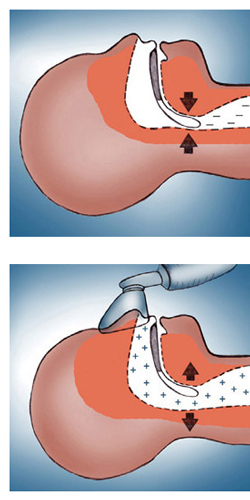
Sleep Apnea
Obstructive Sleep Apnea (OSA)
Obstructive Sleep Apnea (OSA) is the most common type of sleep apnea. It is estimated to affect up to 30% of adults in the United States, but in many cases it goes undiagnosed. OSA occurs when the airway at the back of the throat becomes constricted or blocked during sleep, which may cause snoring as air is prevented from passing through normally. The primary causes of airway obstruction are a lack of muscle tone during sleep, excess tissue in the upper airway and abnormalities in the upper airway and jaw.
 People with sleep apnea experience repeated reductions or pauses in breathing for brief periods while they sleep, but may not fully wake up or become aware that their nighttime breathing is abnormal. Certain symptoms of obstructive sleep apnea may not be immediately noticeable to the person with the condition. For example, abnormal breathing and snoring may only come to a person’s attention after they are observed by a bed partner.
People with sleep apnea experience repeated reductions or pauses in breathing for brief periods while they sleep, but may not fully wake up or become aware that their nighttime breathing is abnormal. Certain symptoms of obstructive sleep apnea may not be immediately noticeable to the person with the condition. For example, abnormal breathing and snoring may only come to a person’s attention after they are observed by a bed partner.
A person with the following frequent symptoms may be a candidate for a sleep study (usually prescribed by a physician), to help properly determine if they require treatment for OSA:
- Excessive daytime sleepiness
- Loud snoring
- Gasping or choking sounds
- Headaches in the morning
- Dry mouth upon awakening
- Restless sleep with periods of wakefulness
- Increased need to get up from bed to urinate
- Irritability or frustration
- Lack of energy; feeling tired
- Reduced focus
Many of the symptoms of sleep apnea can also be caused by other health issues, so the condition cannot be diagnosed by symptoms alone.


